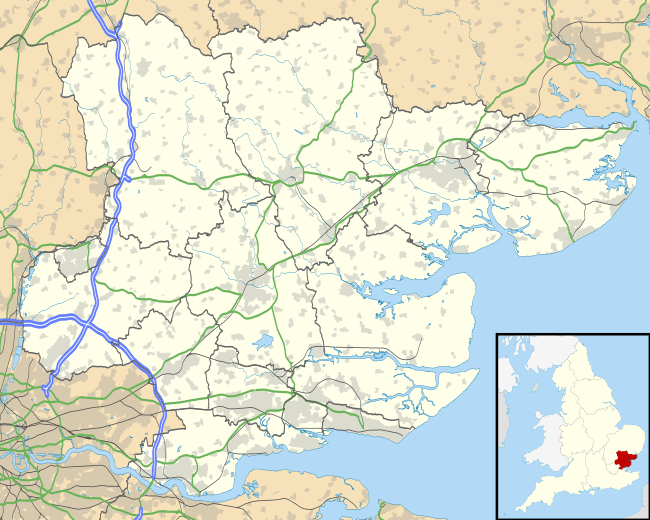Stebbing
| Stebbing | |
 Stebbing High Street |
|
 Stebbing |
|
| Population | 1,300 (2011)[1] |
|---|---|
| OS grid reference | TL677203 |
| District | Uttlesford |
| Shire county | Essex |
| Region | East |
| Country | England |
| Sovereign state | United Kingdom |
| Post town | Dunmow |
| Postcode district | CM6 |
| Dialling code | 01371 |
| Police | Essex |
| Fire | Essex |
| Ambulance | East of England |
| EU Parliament | East of England |
| UK Parliament | Saffron Walden |
Coordinates: 51°53′44″N 0°24′34″E / 51.8956°N 0.4095°E
Stebbing is a small village in the Uttlesford district of northern Essex, England. The village is situated north of the ancient Roman road Stane Street. Its high street contains a pub, and a bowling green. About 1500 people live in the village.[2] It is 6.4 miles (10.3 km) from the nearest railway station (Braintree railway station), and 7.6 mi (12.2 km) from nearest airport (London Stansted)
History
Stebbing is mentioned in the Domesday Book
"Henry de Ferrers holds Stebbing in demesne which Siward held as a manor and as two hides and 30 acres. Then and later two ploughs in demesne; now 3. Among the men then 4 ploughs now six and a half. There were six villans now eight. Then 16 bordars now 33."[3]
Half a mile north-west of the church is The Mount, the moated earthwork remains of the medieval castle.
In the late 13th century the manor of Stebbing passed briefly to the Scottish noble house of Douglas by virtue of the marriage of William the Hardy, Lord of Douglas to Eleanor de Lovaine, the widow of William de Ferrers of Groby. Eleanor was a ward of Edward I, and had her late husband's manors of Stebbing and Woodham Ferrers made into a dowry for a future re-marriage. Douglas absconded with Eleanor, when she was attending to her late husband's estates in Scotland, and married her c.1288. Douglas, a significant figure on the Scottish side during the First Scottish War of Independence, had his English manors finally forfeited by 1298 when he died of mistreatment in the Tower of London. His son Hugh Douglas having been captured previously at Stebbing in 1296, by the Sheriff of Essex.[4]
The church

The Grade I listed church was built mainly around 1360. An outstanding feature is the stone rood screen, one of only three that survive in Europe (the others are at Great Bardfield and in Trondheim).[5][6] The earliest written record referring to the present church dates from 1377, when it was reported of Henry de Ferrers that he was “said to have been born in the Abbey of Tilty and baptised in the church of St. Mary the Virgin, Stebbing”. During work inside the church a few years ago part of the foundations of an earlier building were uncovered along with coins of King Henry II (1154 - 1189). During restoration work in 2010 remnants were discovered of medieval wall paintings.
Governance
An electoral ward in the same name exists. This ward had a population of 1,560 at the 2011 census.[7]
References
- ↑ "Parish population 2011". Retrieved 27 September 2015.
- ↑ The Stebbing Village Page
- ↑ Domesday Book: A Complete Transliteration. London: Penguin, 2003. ISBN 0-14-143994-7 p.454
- ↑ Fraser, Sir William. The Douglas Book, Edinburgh 1885. vol i, pp.75,78,79,93,192
- ↑ "Church of St Mary the Virgin, Stebbing". British Listed Buildings. 20 February 1967. Retrieved 28 December 2011.
- ↑ Foster, Richard (1982). Discovering English churches: a beginner's guide to the story of the parish church from before the Conquest to the Gothic Revival. Oxford: Oxford University press. p. 126.
- ↑ "Ward population 2011". Retrieved 27 September 2015.
Further reading
- Livesey, C.E. (1924). The Church of St Mary the Virgin, Stebbing. Robus.
See also
External links
| Wikimedia Commons has media related to Stebbing, Essex. |